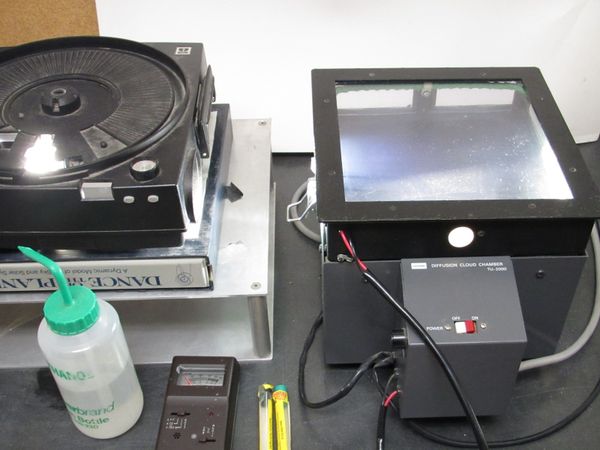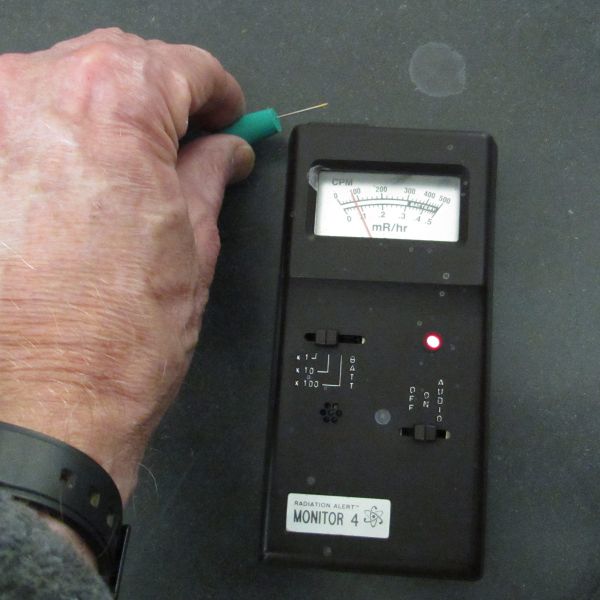Track Cosmic Rays in a Cloud Chamber: Difference between revisions
m (moved Cosmic Rays to Track Cosmic Rays in a Cloud Chamber) |
|
(No difference)
| |
Revision as of 23:44, 6 January 2012
A cloud chamber is a tool that reveals the path of cosmic rays or other energetic charged particles. Because it permits us to measure the track of these particles in three dimensions, even when they are deflected by magnetic fields, the cloud chamber was important in research during the 1930's that started our exploration of the nature of cosmic rays and fundamental particles. For example, in 1932 Carl Anderson discovered the positron in photographs of cosmic rays through cloud chambers. The positron is the antiparticle for an electron, and it is equally well described as an electron traveling backward in time! Anderson won the Nobel Prize for this in 1936, and a year later he discovered the muon, the electron's heavy cousin. Showers of cosmic rays produced in the cascade from the primary's interaction with the atmosphere contain electrons, positrons, and muons.
How They Work
The early cloud chambers were pulsed. Water or some other condensible gas in a closed chamber was suddenly cooled by expanding it rapidly. This produced a supersaturated vapor, but when charged particles passed through it, a cloud would form along the particle track if the conditions were just right. By 1950 a diffusion cloud chamber was developed which operated continuously. It is simple to make and operate, and for several years it was used to investigate fundamental particles and cosmic rays.
Our diffusion cloud chamber is a replica of this design. It is a an insulated metal box about 15 inches on a side. A large window on the top allows you to look down on the black interior. Inside the box and below the surface you see is space for a dry ice -- frozen carbon dioxide (CO2). The dry ice cools the bottom pan to about -78 C. The pan is covered with methyl alcohol (wood alcohol). The vapor of the methyl alcohol becomes supersaturated as warm alcohol rises along the sides of the box and diffuses toward the cold pan at the bottom. The saturated vapor is illuminated through windows in the side of the box. The arrangement of a cloud chamber and an illuminating projector is shown in the photo.
Dry ice cools the interior of a cloud chamber where methyl alcohol forms a supersaturated vapor. Cosmic rays passing through the vapor cause it to condense and mark tracks of the particles. A slide projector illuminates the tracks from the side to make them visible briefly.
Clean the Windows
The cloud chamber we will use for this experiment in the lab has two light sources and a high voltage power supply. The voltages are a shock hazard if the power is on while the chamber is open. Make sure that the power switch is ``off when the chamber is open. Check that the windows are clear. You may need to clean them off with a little distilled water on a paper towel. It helps if you do this this just before you close the chamber. If you leave a thin film of distilled water on the windows they will be less likely to fog when the chamber is cooled.
Add Dry Ice
To see cosmic rays you will need to create supersaturated alcohol vapor inside the chamber. The first step is to add the dry ice that will cool the alcohol. The assistant will help crush solid CO2 (dry ice) to a powder. The dry ice should be enough to cover the Teflon plate that forms the bottom of the cloud chamber with a layer 1 to 2 cm deep. If there is not enough, the temperature will not be uniform, and convection currents will interfere with track formation. Place the dry ice on the Teflon inside the box; springs below the plate will push it into contact with the bottom of the chamber. Because dry ice is so cold that it could burn you, whoever handles it has to wear gloves and be very careful. It is best to let the assistant do this for you, but you should observe the process. After the dry ice is in place, fasten the chamber back onto the box. There are hooks and clasps on the side that hold things in place. Check to be sure that the chamber is level. There are three adjusting screws on the bottom for this purpose.
Add the Alcohol
The bottom plate of the chamber has felt on one side. Pour a generous amount of methyl alcohol into the bottom of the chamber and insert the bottom plate felt side down. Make sure that there is enough alcohol to cover the bottom of the chamber and to saturate the felt completely. The felt wrapped wires on the inside should also be saturated with alcohol. The felt should be soaked until soggy, but there should not be a puddle of alcohol in the bottom. Too much alcohol makes an insulating layer, but too little alcohol prevents vapor from forming.
Place the top on the chamber and make sure that it is securely shut. There should be no gaps between the lid and the chamber. It helps if there is a thin water film on the inside of the observation window. The assistant will help you to make certain that the amount of alcohol is about right.
Adjust the Illumination
There are two tricky things about making the cloud chamber work well: creating a supersaturated vapor and illuminating the chamber so that you can see tracks. It works best if the light enters the chamber without hitting the edge of the bottom pan. Once you think you have the projector adjusted right, turn off the lights and wait about 10 minutes. This should be enough time for the alcohol vapor to reach the proper state. The high voltage clearing field should be off while the chamber cools.
Look for Cosmic Ray Tracks
Turn on the lamps. The room lights should be off. Look down into the chamber. Near the bottom you should see a light fog from large droplets. As you watch, suddenly a straight track will appear when a charged particle zips through the chamber. Once you have seen one track, it will be easier to recognize others. If you don't succeed soon, ask for help. It is possible that things are working and you can't find tracks because the lighting is wrong. Once tracks are visible, experiment with the high voltage clearing field. This may help to dissipate the clouds that results from frequent track formation, but usually we do not need to turn the high voltage on at all.
Answer These Questions
With the help of your partner, count the tracks which form over a 1 minute period.
1.How many cosmic rays pass through this chamber each minute? (Each student who is doing this should make their own count.)
2. Were all the tracks similar, or were some distinctly different? Explain your answer and provide a sketch.
Ask the assistant for help with the radioactive sources. We have alpha (He nuclei) and beta (electrons) sources on small needles that may be inserted into the side of the cloud chamber. The figure shows the beta source at the window of a particle counter. The counter measures the number of charged particle pairs created per second by the source in units of roentgens per second. A milli-roentgen is about 2 million charged particle pairs per second.
First try the alpha source. Alpha particles are actually helium nuclei, but they are emitted in the decay of some heavy naturally radioactive elements. We have a very weak radioactive source on the tip end of a needle that can be inserted into the cloud chamber. The assistant will show you how to do this. You will notice immediately that there are very many alphas coming from the tip of the needle.
3. Describe the alpha particle tracks and how they differ from the cosmic ray tracks.
Now with the help of the assistant insert the beta particle source into the chamber.
4. Describe the beta particle tracks and how you distinguish them from the alphas.
If you were successful with the cloud chamber and you saw cosmic rays, and if you take our word for it that many of these were muons, then you have just seen special relativity at work. The muon lifetime was slower for you than it was for the muon, because the muon was moving past you. Suppose that the muons you saw were moving at 98\% of the speed of light, about 296,940 km/sec.
5. Use the time dilation formula with v/c=0.98 and figure out how long such a muon seems to us to live. Will these muons reach us from an altitude of 3000 meters, slightly less than 10,000 feet?
The volume of a box is
V = X x Y x Z
where X, Y, and Z are its dimensions.
6. Measure the chamber and calculate its volume. Your measurement should be made in centimeters, so that the volume you calculate will be in cubic centimeters.
7. In the same units, estimate your own volume. You may use any method you like, but explain what you did, and give your answer in cubic centimeters.
8. How much more volume do you have than the cloud chamber?
9. The probability that a cosmic ray will hit you is proportional to your volume. For example, if you are 100x larger than the cloud chamber, then 100x as many cosmic rays go through you as through the chamber each minute. How many cosmic rays go through you in one minute?
10. How many cosmic rays go through you in one day (24 x 60 minutes)?
Consequences
Cosmic rays may be responsible for the random changes in DNA that create mutations and are part of the process of evolution for both plants and animals. The Earth's magnetic field protects us from some cosmic rays (clearly, not all), but the field is not constant. In fact, the field reverses fairly often, every 100,000 to 1,000,000 years. Whenever the field does reverse, it goes through a period with no field at all, and we are completely unprotected from low energy cosmic rays. Add this one to the growing list of likely astronomical catastrophes --
- Overheating from the greenhouse effect when fossil fuels add too much CO2> to the atmosphere
- Cancer from ultraviolet sunlight when the ozone hole caused by fluorocarbons spreads to low latitudes
- Years of winter when sunlight is blocked by dust after an asteroid or comet hits the Earth
- The loss of the biosphere after the evolution of the Sun ultimately destroys all water on the Earth
- The unavoidable slow death of the universe as it expands and cools.


